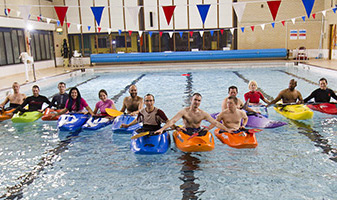Range of housing types
The range of housing types that should be made available is as wide as that for people without learning disabilities. In this section the whole range has been split into various general types although it has to be stated that there is much crossover between types. There are also some suggestions about the general advantages and disadvantages of each type, although it must be stressed that different people will view advantages and disadvantages according to their own preferences. Choice is very much a personal thing.
Group homes
Group accommodation for up to four people in one house or flat can be provided with
varying levels of support for different residents, including those with the need for very high
levels of support and live-in support.
The advantages of this model are that relevant support can be made available on demand, the availability of compatible friendships, company and activity with other co-residents, yet also an ability to live one’s own life in a separate room if desired. Group homes can offer a high degree of staff contact.
The closeness of others can be a disadvantage for those of a very independent frame of mind and group treatment needs to avoided by good practice providers. Systems such as Active Support can be used to ensure maximum independence and engagement of coresidents in their home and community life.
Independent living
Independent living separates the provision of housing from the “support” people need to live. People can live in a range of houses and flats from a number of different housing providers, depending on availability and choice, and they hold their own tenancies or have ownership arrangements. Support can be offered in a range of ways and at different levels of intensity depending on individual need. Continuing the theme from group homes, the advantages of the model are that it empowers the individual to make their own decisions about their lives, to make choices about what they do, when and where. Support can be tailored to the person and not overpower the person’s own independence. People can have a lot of control over their environment, depending on their tenancy agreement of ownership of their home.
The following are examples of how support can be delivered to people living in independent living:
- The Keyring housing model
Offers independent housing for several people living within the same neighbourhood. A relatively low level of support is usually needed and is provided by an individual volunteer who lives in one of the housing units. The Keyring emphasis on neighbourhood also offers the opportunity for people to support one another and offers the benefits of a ready-made community of people. This model is not available in Cardiff. - Intensively supported independent living.
This model has been offered to people with autism and/or challenging behaviour who find it difficult to live within a shared setting and who might otherwise be more expensively accommodated out of county. In this model 12 to 15 units are situated near to one another, some with living space for individual support workers, although general support for the whole scheme needs also to be centrally located, along with some community facilities. Each unit is fitted with modern technological support aids and systems. Joint funding with the LHB is common for such a scheme. - Warden assisted group of flats and/or houses
This form of housing is a more supportive version of Keyring, offering accommodation and support for up to fifteen people living on the same site or in the same area. As well as an independent living unit, there are also communal facilities such as a lounge and laundry. Residents usually have quite high support needs or wish to live in separate accommodation while still taking advantage
of communal facilities and a sense of community among tenants. A live-in warden
supervises the support that tenants require.
The above models are sometimes referred to as ‘Core and Cluster’. - Supported living own tenancy
This form of housing enables a person to live independently in their own home
with twenty four hour support provided by a dedicated, consistent, experienced
staff team. Services include supporting the individual to develop independent living
skills such as: shopping, household chores, planning and preparing meals, budgeting and paying bills, cooking and cleaning; support to access the local community, help with personal care and maintaining the tenancy.
Life sharing arrangements
There are various ways in which life sharing arrangements can be made. People can offer a place in their own home or elect to move in with a person with a learning disability either on a voluntary basis or with some form of payment.
Generally the advantages of sharing one’s life with others are to have a close personal relationship with particular people to whom one is attached, to have constant, accessible support and, through the sharing person, have access into local community network.
Disadvantages are that life sharing might inhibit a sense of independence and that success will be dependent on compatibility and the quality of the relationship. This means that great care is needed in creating the match between the sharers and argues for a scheme to provide matching and monitoring services.
The following are examples of how life sharing can be arranged:
- Shared living (formerly known as adult placement)
Living with a well-matched “host” family or individual provides a shared life within the carers’ own family and with access to their social networks in a local community setting. Shared Lives carers can provide long or short term, full time or part time accommodation, support and care for up to two people. They are part of organised Shared Lives schemes which approve and train carers and monitor arrangements. Shared Lives carers do not employ staff and provide all the care and support themselves. - Supported lodging
This is very similar to Shared Lives (adult placement) in that the individual has a tenancy, licence or lodging in someone’s home. The person can receive support through the person providing lodgings, although this is likely to be less support than might be provided in more formal Shared Lives arrangement. - Flat or annex in a family home
This form of accommodation offers individually created facilities to people who wish to live separately but to have family support nearby. - Living with a support tenant
An individual, a couple or a small group of people, usually with quite low support needs, live in a house or flat with a support tenant.All have their separate accommodation in the home and the support tenant, who usually has another job, gets free accommodation and a small honorarium for delivering whatever support is require.
Housing for Older People
Wherever possible the principle should be to allow people to live in their own homes with
relevant support if they wish to do so. Several of the types of accommodation mentioned above are relevant for older people and will deliver the positive outcomes they do for younger people. Where people’s personal care needs increase with age, the same opportunities for housing, residential carand nursing homes and dementia services for older people should also be available to people with learning disabilities.
One emerging model may be particularly useful in the future:
- Extra care housing
Extra care housing provides different types of housing such as self-contained flats or bungalows but with more extensive communal facilities and the opportunity for increasing amounts of care, including domiciliary care and nursing care, to be provided as necessary.
Intentional communities
An intentional community is a distinct community of people with varying levels of learning disabilities who live in community with non-disabled people supporting them, usually
according to a strong communal philosophy based on sharing lives and on work. Intentional communities might be based on a campus or on dispersed housing in the local community or both. They seek to integrate into their local community. They might be rural or urban, large or small according to the wishes and needs of the individuals. Their accommodation arrangements could be regarded as group homes, independent living or shared lives arrangements mentioned above.
The main advantages of an intentional community are an active social and working life
and the strong sense of friendship and company. There tends to be greater consistency in the staff team with consequent benefits to people with learning disabilities. The disadvantages are that some might prefer a quieter or a more independent lifestyle with more privacy and, in some forms, communities can be geographically isolated.
Residential care home
Specialist residential care homes for people with learning disabilities involve a fully integrated package of accommodation and care and require registration under the Care Standards Act 2000. These are becoming less as group home and independent living forms of housing are achieving significant levels of care, for people along with a high degree of autonomy.
An advantage is that residential care homes can provide extensive personal care support and facilities according to the wishes of residents, and can provide appropriately for people with higher support needs. Disadvantages are that registered residential care homes can be larger in size than other accommodation forms, with associated difficulties in maintaining an individualised approach.









